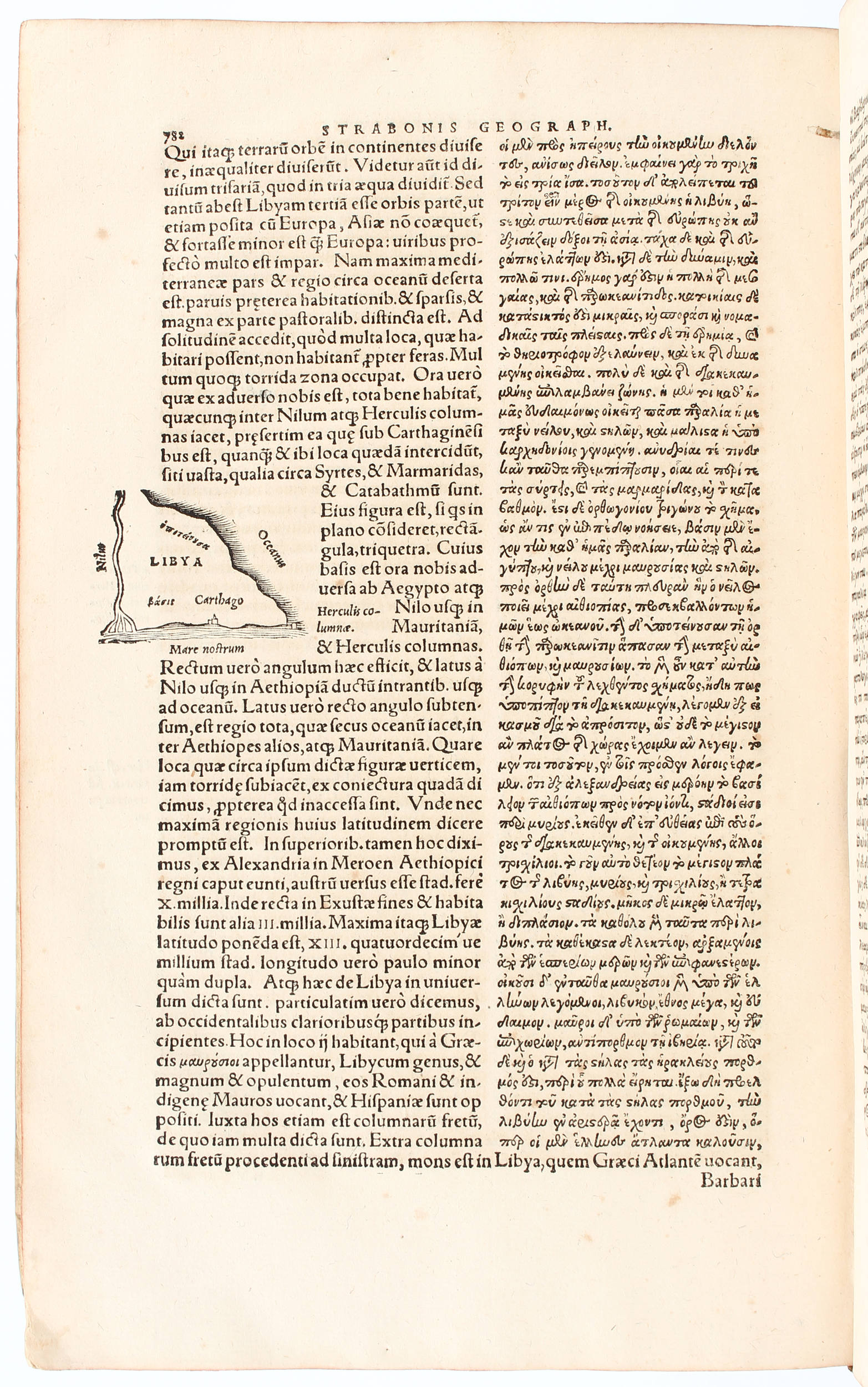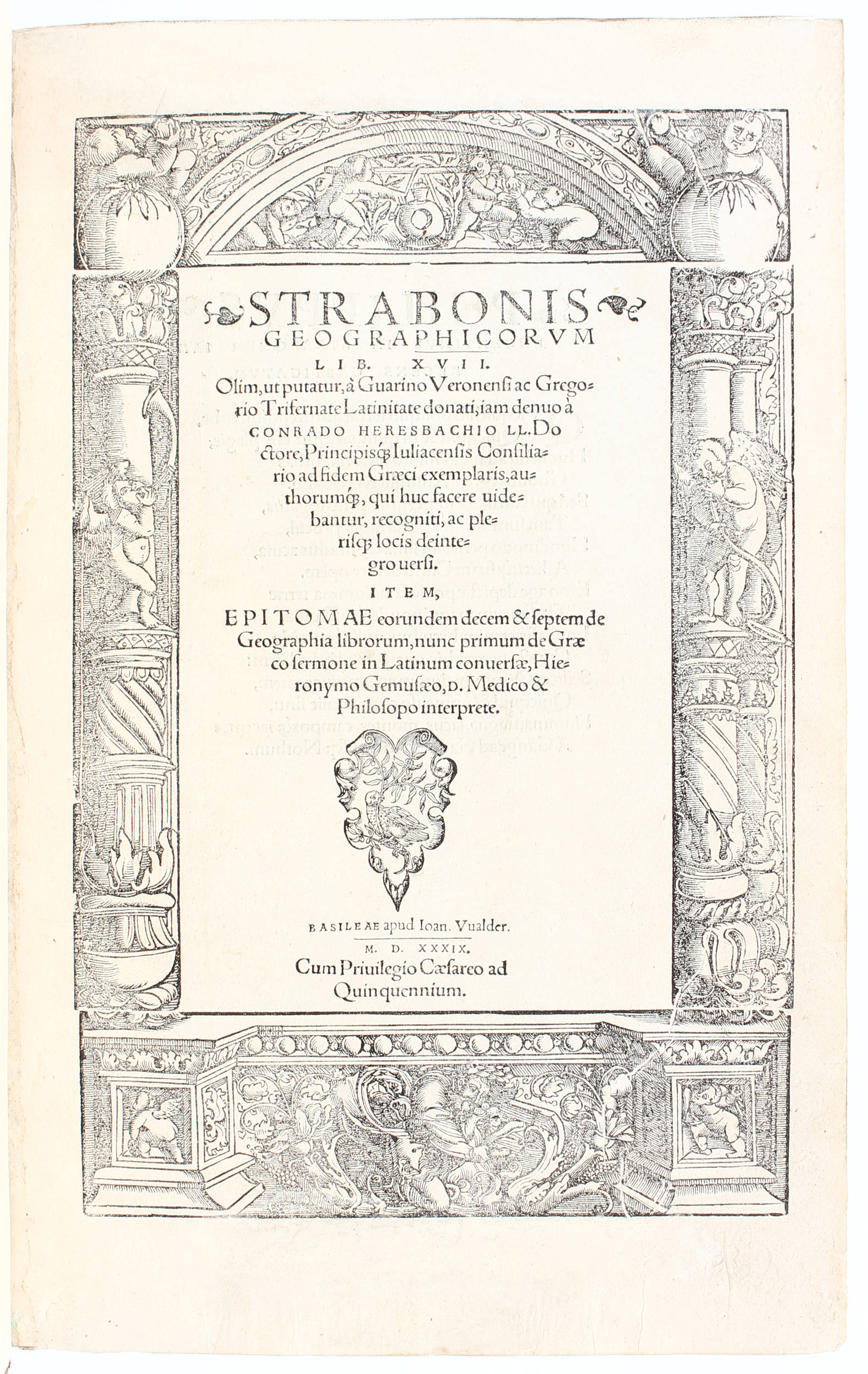STRABO (64/63 B.C.-ca. 25 A.D.). De situ orbis , in Greek. Edited by Benedictus Tyrrhenus (15th/16th century). Venice: Andreas Torresanus at the Aldine Press, November 1516. Aldine 2 o (302 x 201 mm). 198 leaves. Types: 79 Greek, 90 Greek, 80 italic, cut by Francesco Griffo. Woodcut headpieces, typographical headings and 11-line woodcut initials opening each book PRINTED IN RED, Aldine device on title and final verso. Carefully ruled in red by a modern owner. (Title and last leaf cut out and inlaid, some foxing especially in latter half, lightly washed deleting some early annotations.) 19th-century Russia gilt, edges gilt over red-staining (rebacked, extremities rubbed). Provenance : Frank Dougall Crane (bookplate). EDITIO PRINCEPS of one of the earliest and most important scientific treatises of historical geography. Strabo's only surviving work, the Geography constituted the first attempt at a unified treatise of geographical knowledge. The work surveys the topography, history and political characteristics of the principal regions of the Roman world. In bringing up to date the work of the first systematic geographer, Erastothenes (3rd century B.C.), whose writings are now lost, Strabo relied on other Greek sources but paid scant attention to recent Roman records. His treatise brought together philosophy, political theory, geology, mathematics, and history. Following Erastothenes, he presented the world as a single ocean-girt landmass on the northern half of a sphere, immobile within a revolving universe. He "devoted much attention to the forces that had formed the oikoumene [inhabited land]... Strabo suggested that some islands were torn from the mainland by earthquakes, while others (including Sicily) were thrown up by volcanic action. He gave examples of both local and widespread land subsidence and alluded to the uprising of seabeds with consequent flooding; he further described the silting of rivers that form alluvial plains and deltas" (DSB). His descriptions of the Mediterranean regions, Asia Minor and Egypt are excellent, while those of Gaul, Britain and Greece are weaker (the errors relating to his native country may have been due to his excessive veneration of Homer, whose authority he extended to geography). That Strabo's geography was unknown to the Romans, even to Pliny the Elder, in spite of his expressed wish that it be read by the statesmen and rulers of the Empire, is evidence that it may have been published far from Rome. The work was not generally known until the 5th century, but came to be the standard geographical reference work during the Middle Ages. It was first published in Latin by Sweynheym and Pannartz in 1469. For this first edition in Greek Tyrrhenus and Torresanus had to use a manuscript of little authority (BNF Paris gr. 1395). Shortly after Aldus's death in 1515 the great Hellenist philologist Marcus Musurus had written to Jean Grolier urging him to encourage Torresanus, the new head of the press, to publish a number of Greek texts in danger of disparition, naming the Old and New Testament, Aristotle, Galen, Strabo, Pausanias and others (cf. Wilson, p. 156). Although Musurus may have been involved in the early stages of the project, no mention is made of him in Tirreno's preface to Alberto Pio (1475-1531), Prince of Carpi and Aldus's former pupil. Adams S-1903; Ahmanson-Murphy 130; Renouard 77.7.
STRABO (64/63 B.C.-ca. 25 A.D.). De situ orbis , in Greek. Edited by Benedictus Tyrrhenus (15th/16th century). Venice: Andreas Torresanus at the Aldine Press, November 1516. Aldine 2 o (302 x 201 mm). 198 leaves. Types: 79 Greek, 90 Greek, 80 italic, cut by Francesco Griffo. Woodcut headpieces, typographical headings and 11-line woodcut initials opening each book PRINTED IN RED, Aldine device on title and final verso. Carefully ruled in red by a modern owner. (Title and last leaf cut out and inlaid, some foxing especially in latter half, lightly washed deleting some early annotations.) 19th-century Russia gilt, edges gilt over red-staining (rebacked, extremities rubbed). Provenance : Frank Dougall Crane (bookplate). EDITIO PRINCEPS of one of the earliest and most important scientific treatises of historical geography. Strabo's only surviving work, the Geography constituted the first attempt at a unified treatise of geographical knowledge. The work surveys the topography, history and political characteristics of the principal regions of the Roman world. In bringing up to date the work of the first systematic geographer, Erastothenes (3rd century B.C.), whose writings are now lost, Strabo relied on other Greek sources but paid scant attention to recent Roman records. His treatise brought together philosophy, political theory, geology, mathematics, and history. Following Erastothenes, he presented the world as a single ocean-girt landmass on the northern half of a sphere, immobile within a revolving universe. He "devoted much attention to the forces that had formed the oikoumene [inhabited land]... Strabo suggested that some islands were torn from the mainland by earthquakes, while others (including Sicily) were thrown up by volcanic action. He gave examples of both local and widespread land subsidence and alluded to the uprising of seabeds with consequent flooding; he further described the silting of rivers that form alluvial plains and deltas" (DSB). His descriptions of the Mediterranean regions, Asia Minor and Egypt are excellent, while those of Gaul, Britain and Greece are weaker (the errors relating to his native country may have been due to his excessive veneration of Homer, whose authority he extended to geography). That Strabo's geography was unknown to the Romans, even to Pliny the Elder, in spite of his expressed wish that it be read by the statesmen and rulers of the Empire, is evidence that it may have been published far from Rome. The work was not generally known until the 5th century, but came to be the standard geographical reference work during the Middle Ages. It was first published in Latin by Sweynheym and Pannartz in 1469. For this first edition in Greek Tyrrhenus and Torresanus had to use a manuscript of little authority (BNF Paris gr. 1395). Shortly after Aldus's death in 1515 the great Hellenist philologist Marcus Musurus had written to Jean Grolier urging him to encourage Torresanus, the new head of the press, to publish a number of Greek texts in danger of disparition, naming the Old and New Testament, Aristotle, Galen, Strabo, Pausanias and others (cf. Wilson, p. 156). Although Musurus may have been involved in the early stages of the project, no mention is made of him in Tirreno's preface to Alberto Pio (1475-1531), Prince of Carpi and Aldus's former pupil. Adams S-1903; Ahmanson-Murphy 130; Renouard 77.7.

.jpg)



.jpg)









Testen Sie LotSearch und seine Premium-Features 7 Tage - ohne Kosten!
Lassen Sie sich automatisch über neue Objekte in kommenden Auktionen benachrichtigen.
Suchauftrag anlegen